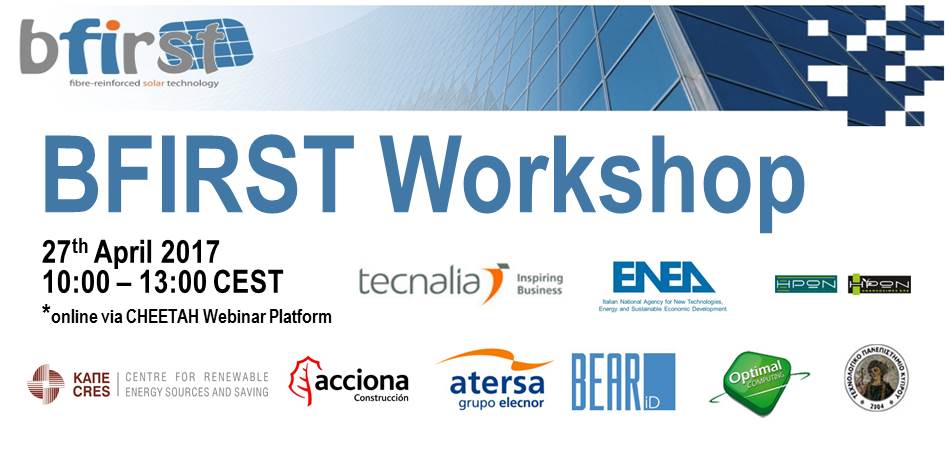BFIRST Workshop 27th April 2017 10:00 – 13:00 CEST

Building-integrated photovoltaics (BIPV) is currently a growing market worldwide, with an estimated compound annual growth rate (CAGR) of 18.7% and a total of 5.4 GW installed between 2013 and 2019 (Transparency Market Research, 2014).
One of the main drivers for BIPV market growth in the EU is the increasingly demanding legislation related to energy performance in buildings, given the fact that buildings are responsible for 40% of energy consumption and 36% of CO2 emissions in the EU. Europe has therefore an urgent need to make its building stock more energy efficient and smarter.
Despite this favourable framework, there are key requirements related to the flexibility in design and aesthetics considerations, the demonstration of long-term reliability of the technology and compliance with legal regulations and cost effectiveness are only partly covered by the available technologies
EU funded “Building-integrated fibre reinforced solar technology” - BFIRST project (Grant Agreement number 296016) started in May 2012 has the aim to contribute to bridging the gap between technological development and market demands, being oriented at the design, development and demonstration of a portfolio of innovative PV products for building integration, based on c-Si cell encapsulation within fibre-reinforced composite materials.
The project ended April 2017. This workshop reports the results of developed monolithic and lightweight structures, highly versatile in terms of geometries, shapes, colours and surface finish. Multi-functionality in the building environment has also been addressed through design and materials tailoring. Full architectural integration of the developed products has also been pursued. The compliance with the corresponding IEC test standards and the demonstration of multifunctional performance in real operation conditions has also been the ultimate objectives of the project
Agenda:
| Chairperson: George Halambalakis, CRES (Greece) | |
|
10:00 |
Introduction |
|
10:10 |
Building Integrated PhotoVoltaics: presentation in memoriam of prof. Yiannis Tripanagnostopoulos, University of Patras. Prof. Soteris Kalogirou, CUT (Cyprus) |
|
10:30 |
Development and demonstration of standardized building-integrated components based on fiber-reinforced solar technology. |
|
11:00 |
Product guidelines for energy producing composite components. Tjerk Reijenga, BEAR-iD (The Netherlands) |
|
11:20 |
Building-integrated products based on fiber-reinforced solar technology. José Maria Puig, ATERSA (Spain) |
|
11:50 |
Demonstration of multifunctional BFIRST products in real operation conditions. Evangelos Mathas, CRES (Greece) |
|
12:20 |
Monitoring of developed products in the three demo sites. Michele Pellegrino, ENEA (Italy) |
|
12:50 |
Comments & discussion |
More info and contacts:
Contact for more information: Evaggelos Mathas, CRES
For any further technical information about connection and assistance:
Notes for BFIRST Project:
The project is coordinated by Tecnalia, private research centre and main developer of the composite encapsulation technology and joins efforts between the building industry (represented by Acciona, BEAR Holding, Optimal Computing and Heron), the PV industry (Atersa) and RTD performers (Tecnalia, CRES, ENEA and Cyprus University of Technology). Specific attention is paid to dissemination and communication activities, led by CRES.


